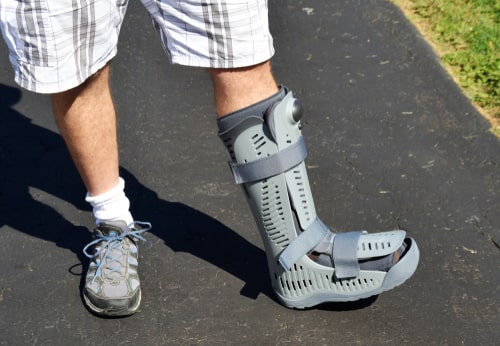A stress fracture is a tiny crack in a bone. Stress fractures are often caused by repetitive physical activities, like running long distances, without adequate time for bones to recover from stress. They can also be caused by osteoporosis. Though often small and seemingly insignificant, stress fractures can lead to substantial discomfort and long-term issues if not properly treated.
At Apex Orthopaedics Spine & Neurology in Charlotte, North Carolina, we understand the impact these injuries can have on your daily life. Whether you’re a seasoned runner, a senior, or someone experiencing unexplained pain, we are here to provide comprehensive treatment for broken bones.
In this blog post, we’ll delve into what stress fractures are, how they occur, and the steps you can take to prevent and treat them effectively.
What Is a Stress Fracture?
Fractures are broken bones. Stress fractures, also known as hairline fractures, are tiny cracks in bones. Stress fractures are usually overuse injuries that happen when repetitive physical activity puts too much pressure on bones. However, people whose bones have been weakened by osteoporosis can develop stress fractures with normal activity.
Cleveland Clinic explains that stress fractures begin as inflammation on a bone’s surface. This stress reaction is like a bone bruise. If something continues putting pressure on the same spot before the injured bone can heal properly, the bone can crack and cause a stress fracture.
Types of Stress Fractures
Most stress fractures affect weight-bearing bones in the lower body, such as:
- Lower leg (tibia and fibula).
- Foot (especially the metatarsals that connect your ankle and heel to your toes).
- Heel (calcaneus).
Less commonly, stress fractures can affect bones in your:
- Lower back (lumbar spine).
- Hips.
- Hands and wrists.
Causes of Stress Fractures
Most stress fractures happen when a bone doesn’t have enough time to recover from repetitive physical activity. They usually develop gradually over a lengthy period from repetitive motion. People who play sports or work in physical jobs have a higher risk of stress fractures.
Stress fractures can also develop in bones weakened by osteoporosis.
Risk Factors
Understanding the risk factors can help you prevent stress fractures. Here are some key risk factors:
- High-Impact Sports: Activities such as running, basketball, and gymnastics place repetitive stress on the bones, increasing the risk of stress fractures.
- Sudden Increase in Physical Activity: Rapidly intensifying an exercise program without allowing your body to adjust can lead to stress fractures.
- Foot Problems: Structural issues like flat feet or high arches can cause uneven distribution of weight and stress on the bones.
- Being Female: Women with irregular menstrual cycles are at a higher risk due to lower bone density. This is a concern for female athletes.
- Weakened Bones: Conditions such as osteoporosis reduce bone density, making bones more susceptible to fractures.
- Previous Stress Fractures: A history of stress fractures puts you at increased risk of having more.
- Lack of Nutrients: Eating disorders and insufficient calcium and vitamin D can weaken bones.
- Worn Footwear: Worn-out or inappropriate shoes that lack cushioning can increase the risk of a stress fracture in your foot.
Symptoms of a Stress Fracture
Initially, the pain from a stress fracture might be subtle and easy to overlook, but it typically intensifies over time. Tenderness often begins at a specific point and lessens during periods of rest. Swelling may also develop around the affected area.
How Is a Stress Fracture Diagnosed?
Diagnosing stress fractures begins with a physical exam where a healthcare provider will evaluate the affected area for tenderness, swelling, and pain. The doctor may ask about your activity level, medical history, and any recent changes in your exercise routine to better understand the underlying cause. The doctor may order imaging tests to confirm the diagnosis.
Initial X-rays may not always detect stress fractures, especially if they are small or in the early stages. Therefore, more advanced imaging techniques such as computed tomography (CT) scans or magnetic resonance imaging (MRI) may be necessary. These tests provide detailed images of the bone and surrounding tissues, allowing for a more accurate diagnosis and the development of an effective treatment plan.
How Are Stress Fractures Treated?
Treating stress fractures effectively requires a multifaceted approach that addresses both the immediate injury and any underlying factors that may have contributed to its development. Here’s a look at the various treatment options available.
Rest and Activity Modification
The cornerstone of stress fracture treatment is rest. Reducing or completely stopping the activity that caused the stress fracture allows the bone to heal. This may involve avoiding high-impact activities like running or jumping and switching to low-impact exercises such as swimming or cycling.
It’s crucial to follow your doctor’s recommendations on how long to rest and when it’s safe to gradually return to your normal activities.
Protective Footwear and Bracing
Using protective footwear or a brace can help offload the stress from the affected bone, providing additional support and reducing pain. This might include wearing stiff-soled shoes, orthotic inserts, a brace, or a walking boot. In some cases, crutches may be recommended to completely offload weight from the injured area.
Physical Therapy
Once the initial pain and swelling have subsided, physical therapy can play a key role in recovery. A physical therapist will guide you through exercises designed to improve strength, flexibility, and balance, which can help prevent future injuries. They may also provide specific recommendations on how to safely return to your sport or activity.
Medications
Over-the-counter pain relievers such as acetaminophen can help relieve pain and reduce swelling. Nonsteroidal anti-inflammatory drugs (NSAIDs) like ibuprofen are often used, but there is some evidence that they may interfere with bone healing, so their use should be discussed with your doctor.
Nutritional Support
Proper nutrition is vital for bone health. Ensuring adequate intake of calcium and vitamin D can promote healing and strengthen bones. Your doctor may recommend supplements if your dietary intake is insufficient. Addressing any underlying eating disorders or nutritional deficiencies is also essential to prevent recurrence.
Gradual Return to Activity
As healing progresses, it’s important to follow a structured plan for gradually returning to your normal activities. Slowly increase the intensity and duration of your exercise under the supervision of your healthcare provider. Monitoring for any signs of pain or discomfort during this period is crucial to avoid re-injury.
Surgery
In rare cases where the stress fracture does not heal with conservative treatment, or if it occurs in a high-risk area where healing is particularly challenging, orthopedic surgery may be necessary. Surgery typically involves the placement of pins, screws, or other hardware to stabilize the bone and facilitate healing. This option is usually considered only after all other treatments have been exhausted.
How Long Does It Take a Stress Fracture to Heal?
The healing time for a stress fracture varies depending on the severity of the fracture, its location, and your overall health. Generally, most stress fractures take about 6 to 8 weeks to heal with proper rest and treatment.
However, certain factors such as the specific bone affected and underlying health conditions can influence the recovery timeline. For instance, stress fractures in weight-bearing bones like the tibia may take longer to heal compared to those in less stressed areas.
It’s crucial to avoid activities that could exacerbate the injury and to follow your doctor’s guidance closely.
Contact Our Charlotte Orthopedic Doctors for the Best Treatment!
At Apex Orthopaedics Spine & Neurology, we tailor our treatment plans to each individual’s needs, ensuring the most effective approach to healing and preventing future stress fractures. If you suspect you have a stress fracture, our team is here to provide expert diagnosis and comprehensive care.
Contact us today at 704-412-3045 or through our website to schedule an appointment.






